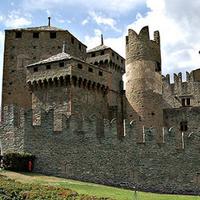6. Chi erano i cavalieri della tavola rotonda?
6. Wer waren die Ritter der Tafelrunde?
6. Who were the knights of the round table?
6. ¿Quiénes eran los Caballeros de la Mesa Redonda?
6) Qui étaient les chevaliers de la Table ronde ?
6. Quem eram os cavaleiros da Távola Redonda?
6. Vilka var riddarna av det runda bordet?
Le leggende britanniche parlano di un grande re chiamato “Arthur”, re Artù.
|legends|British|||||||||Arthur
British legends speak of a great king called "Arthur", King Arthur.
Brytyjskie legendy mówią o wielkim królu zwanym „Artur”, królu Arturze.
Egli viveva in un castello chiamato Camelot dove egli ed i suoi cavalieri sedevano e realizzavano piani attorno ad una grande tavola rotonda.
|||||||||||||they sat||they realized|plans|around|||||
He lived in a castle called Camelot where he and his knights sat and made plans around a large round table.
Mieszkał w zamku zwanym Camelot, gdzie on i jego rycerze siedzieli i snuli plany wokół dużego okrągłego stołu.
Per questo motivo i cavalieri di re Artù erano conosciuti come “i cavalieri della tavola rotonda”.
|||||||||||the||||
For this reason, King Arthur's knights were known as "the knights of the round table."
Ma sono veramente esistiti?
|||you existed
But did they really exist?
Mais ont-ils vraiment existé ?
Ale czy naprawdę istniały?
Artù probabilmente si, e avrebbe avuto uomini che hanno combattuto per lui, ma non si sarebbero vestiti come i cavalieri.
Arthur probably did, and he would have had men who fought for him, but they wouldn't dress like knights.
Arthur l'a probablement fait, et il aurait eu des hommes qui se sont battus pour lui, mais ils n'auraient pas été habillés comme des chevaliers.
Artur prawdopodobnie to zrobił i miałby ludzi, którzy walczyliby o niego, ale nie ubieraliby się jak rycerze.
Provenivano da un periodo di tempo molto precedente.
they came|||||||
They were from a much earlier period of time.
Ils datent d'une époque bien plus ancienne.
Pochodzili ze znacznie wcześniejszego okresu czasu.
Ma chi poteva essere cavaliere?
But who could be a knight?
Potevano diventarlo gli uomini che provenivano dalle buone e ricche famiglie, oppure chi aveva svolto un duro allenamento per diventare paggio e dopo squire.
|to become|||||||||||||performed|||training||||||
The men who came from good and rich families could become one, or those who had undergone a hard training to become a page and then squire.
Mogli nim zostać mężczyźni pochodzący z dobrych i bogatych rodzin lub ci, którzy przeszli ciężki trening, aby zostać paziem, a następnie giermkiem.
Le donne non potevano divenire cavalieri, così come non potevano esserlo gli uomini che provenivano da famiglie ordinarie.
|||||||||||||||||ordinary
Women could not become knights, just as men who came from ordinary families could not be.
Kobiety nie mogły zostać rycerzami, tak jak nie mogli być mężczyźni pochodzący ze zwykłych rodzin.

